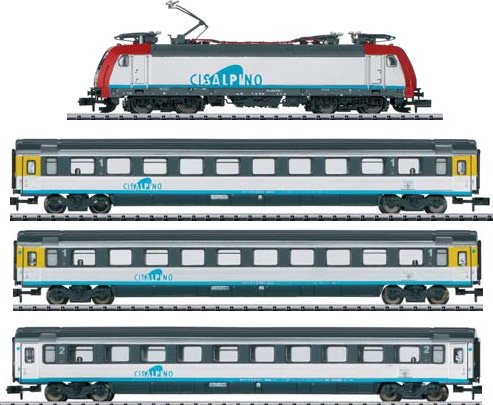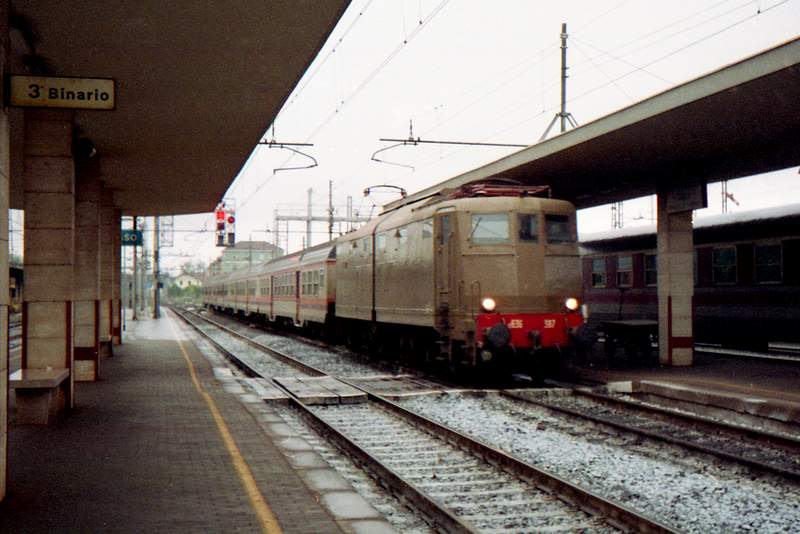Specific Item Information: Prototype: Class Re 484 electric locomotive as a dual system locomotive with 4 pantographs, 2 open seating cars, 1st class, 1 open seating car, 2nd class, all of the cars painted and lettered for Cisalpino AG, used on the Swiss Federal Railways (SBB).
br> Model: The locomotive has a digital decoder for operation with DCC, Selectrix, and Selectrix 2. It has a motor with a flywheel, 4 axles powered, traction tires, and LED headlights. All of the controllable functions can be controlled in the DCC format as well as in the Selectrix 2 format. The express train passenger cars have close coupler mechanisms. Total length over the buffers 613 mm / 24-1/8".
br> Model: The locomotive has a digital decoder for operation with DCC, Selectrix, and Selectrix 2. It has a motor with a flywheel, 4 axles powered, traction tires, and LED headlights. All of the controllable functions can be controlled in the DCC format as well as in the Selectrix 2 format. The express train passenger cars have close coupler mechanisms. Total length over the buffers 613 mm / 24-1/8".
Prototype History: Many modern European trains run using overhead/catenary wire. Rail networks in Western and Central Europe are often well maintained and well developed, whilst Eastern, Northern and Southern Europe often have less coverage and/or infrastructure problems. Electrified railway networks operate at a plethora of different voltages AC and DC varying from 750 to 25,000 volts, and signalling systems vary from country to country, hindering cross-border traffic.
The European Union aims to make cross-border operations easier as well as to introduce competition to national rail networks. EU member states were able to separate the provision of transport services and the management of the infrastructure by the Single European Railway Directive 2012. Usually, national railway companies were split to separate divisions or independent companies for infrastructure, passenger and freight operations. The passenger operations may be further divided to long-distance and regional services, because regional services often operate under public service obligations (which subsidise unprofitable but socially desirable routes), while long-distance services usually operate without subsidies.
The European Union aims to make cross-border operations easier as well as to introduce competition to national rail networks. EU member states were able to separate the provision of transport services and the management of the infrastructure by the Single European Railway Directive 2012. Usually, national railway companies were split to separate divisions or independent companies for infrastructure, passenger and freight operations. The passenger operations may be further divided to long-distance and regional services, because regional services often operate under public service obligations (which subsidise unprofitable but socially desirable routes), while long-distance services usually operate without subsidies.
Road Name History: Swiss Federal Railways (German: Schweizerische Bundesbahnen (SBB), French: Chemins de fer fédéraux suisses (CFF), Italian: Ferrovie federali svizzere (FFS)) is the national railway company of Switzerland. It is usually referred to by the initials of its German, French and Italian names, either concatenated as SBB CFF FFS, or used separately.
The company is headquartered in Bern.
Read more on Wikipedia.
The company is headquartered in Bern.
Read more on Wikipedia.
Brand/Importer Information: Trix is a German company that originally made Trix metal construction sets. one of its co-founders was Stephan Bing, the son of the pioneer toy-maker industrialist Ignaz Bing. In 1935 the company began producing the electrically powered model trains that it became famous for, under the Trix Express label. Prior to the outbreak of World War II the Trix company produced a small range of fairly unrealistic AC powered three rail models running at 14 volts.
N gauge models under the Minitrix brand were made from the late 1960s mostly of European prototypes (German and British primarily). North American prototypes were also manufactured and marketed under the Aurora "Postage Stamp" brand; later these items were sold under the American Tortoise, Model Power and Con-Cor brands. Trix sometimes utilized North American consultants to aid in the design of this portion of the product line. The "Hornby Minitrix' brand was used in the 1980s for a short lived range of British outline models using the earlier product tooling.
Trix's owner in the 1980s and 1990s was Mangold, which went bankrupt in the late 1990s and Märklin purchased the assets in January 1997. In part, this purchase was a reflection of Märklin's need for added production capacity; Trix had been manufacturing certain items for Märklin in previous years. The purchase was also in response to the earlier purchase of the Karl Arnold company by the Italian company Rivarossi; Märklin were very keen to take over Trix market share in 2-rail H0 and especially Minitrix, until then Märklin had not marketed N gauge models. In 2003, Märklin introduced its first N gauge models under the well established Minitrix brand. A number Märklin H0 scale three-rail AC locomotives have also been introduced in two-rail DC versions under the Trix logo and many models are shared between the two brands.
From Wikipedia
N gauge models under the Minitrix brand were made from the late 1960s mostly of European prototypes (German and British primarily). North American prototypes were also manufactured and marketed under the Aurora "Postage Stamp" brand; later these items were sold under the American Tortoise, Model Power and Con-Cor brands. Trix sometimes utilized North American consultants to aid in the design of this portion of the product line. The "Hornby Minitrix' brand was used in the 1980s for a short lived range of British outline models using the earlier product tooling.
Trix's owner in the 1980s and 1990s was Mangold, which went bankrupt in the late 1990s and Märklin purchased the assets in January 1997. In part, this purchase was a reflection of Märklin's need for added production capacity; Trix had been manufacturing certain items for Märklin in previous years. The purchase was also in response to the earlier purchase of the Karl Arnold company by the Italian company Rivarossi; Märklin were very keen to take over Trix market share in 2-rail H0 and especially Minitrix, until then Märklin had not marketed N gauge models. In 2003, Märklin introduced its first N gauge models under the well established Minitrix brand. A number Märklin H0 scale three-rail AC locomotives have also been introduced in two-rail DC versions under the Trix logo and many models are shared between the two brands.
From Wikipedia
Item created by: gdm on 2019-05-18 10:01:59
If you see errors or missing data in this entry, please feel free to log in and edit it. Anyone with a Gmail account can log in instantly.
If you see errors or missing data in this entry, please feel free to log in and edit it. Anyone with a Gmail account can log in instantly.











